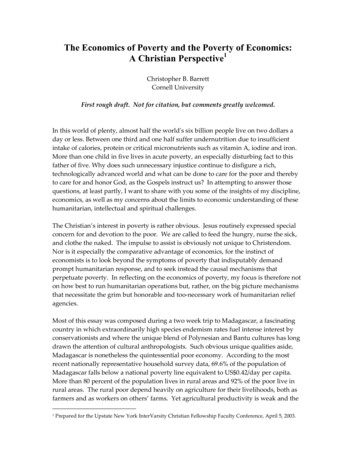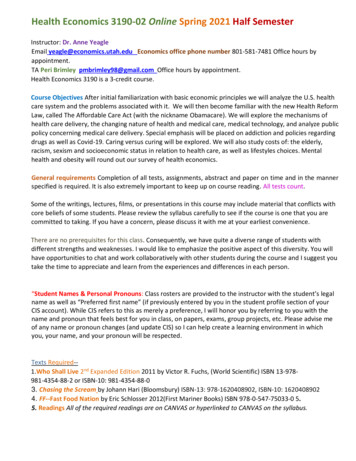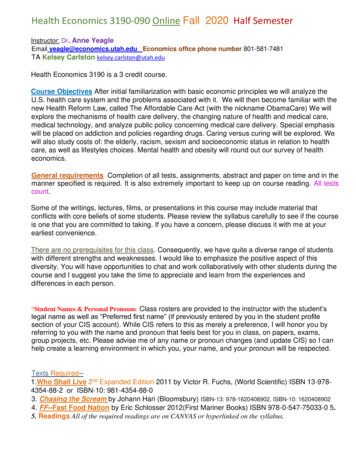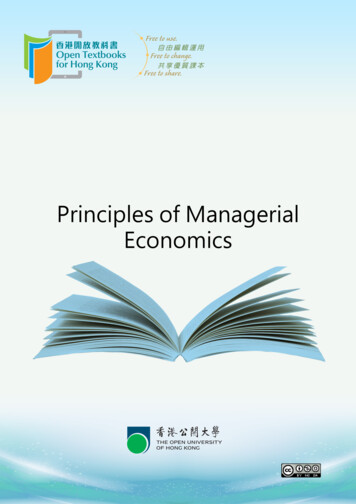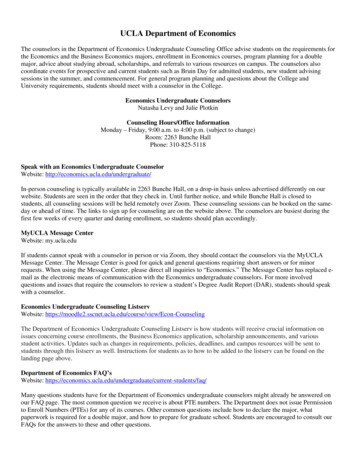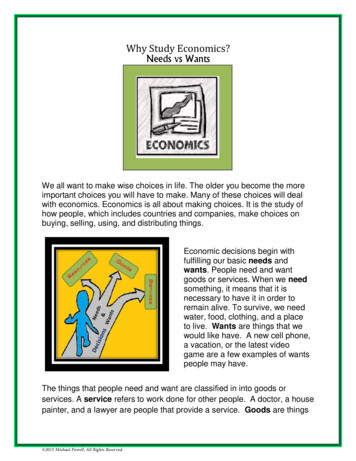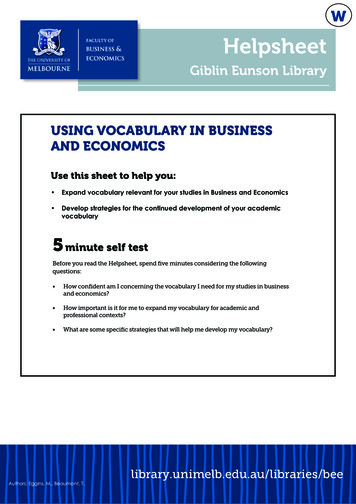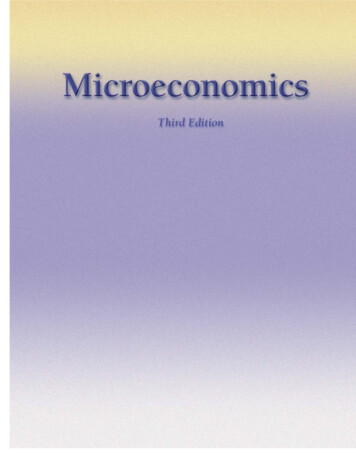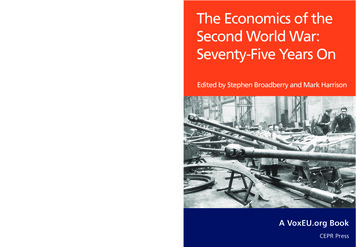
Transcription
This eBook brings together recent research on a range of aspects of the warincluding the extensive war preparations of the great powers; the conductof the war (including the management of economic mobilisation, economicwarfare, economic exploitation, and the role of economists); and the war’sconsequences for demography, inequality, economic recovery and politicalattitudes.The Second World War witnessed the growth and power of economics asa weapon and strategy in warfare. Economics – and economists – wereeverywhere in the war. Economic considerations motivated the war. Thewar was managed with the help of economics. Economic factors powerfullyinfluenced its outcome. There were profound and persistent economicconsequences.The eBook examines the role of economics in the preparations, causes,conduct and consequences of the war. Chapters examine the importance ofeconomic factors in the war preparations, studying the effect of the greatdepression on the German economy and its role in carrying Hitler to power,German economic mobilisation and the transformative rearmament plans ofthe Soviet Union under Stalin. It also explores how lessons learned from theexperience of the First World War affected British preparations for the SecondWorld War and wartime economic management. Other chapters discuss howeconomic factors influenced the conduct of the war, including how Allied airand sea power were used to defeat the Axis, the growth of the Americanwar economy, which raised real GDP by 72% between 1940 and 1945, andthe tragic fate of occupied economies exploited by the Nazis. Finally, authorsexplore the significant economic consequences of the Second World War,including evidence on famine-related deaths and the long road to post-wareconomic recovery.The Economics of the Second World War: Seventy-Five Years OnThe Second World War was the largest conflict in history, touching fivecontinents and changing the lives of millions. The scale of mobilisation of allsectors of the economy and society had redefined the concept of ‘total war’. Itwas the last time that Western societies were mobilised for an all-consumingconflict that demanded years of sacrifice and service from every citizen andevery family. Such watershed moments are sometimes neglected in economics.The Economics of theSecond World War:Seventy-Five Years OnEdited by Stephen Broadberry and Mark HarrisonOverall this eBook provides a unique insight into the importance of economicsand the sometimes overlooked role that economists played in shaping the warand its outcomes. The evolution of economic warfare is revealed, togetherwith how economic factors powerfully influenced WW2’s outcome and itsprofound and persistent economic consequences. The eBook demonstratesthe extent to which economic factors permeated and influenced all levels ofthe preparations, conduct and consequences of the Second World War.Centre for Economic Policy Research33 Great Sutton StreetLondon EC1V 0DXTel: 44 (0)20 7183 8801Email: cepr@cepr.org www.cepr.orgCEPR PressA VoxEU.org BookCEPR Press
The Economics of the SecondWorld War: Seventy-Five Years On
CEPR PressCentre for Economic Policy Research33 Great Sutton StreetLondon, EC1V 0DXUKTel: 44 (0)20 7183 8801Email: cepr@cepr.orgWeb: www.cepr.orgISBN: 978-1-912179-31-2Copyright CEPR Press, 2020Cover image by Archivist
The Economics of the SecondWorld War: Seventy-Five Years OnEdited by Stephen Broadberryand Mark HarrisonA VoxEU.org eBook
Centre for Economic Policy Research (CEPR)The Centre for Economic Policy Research (CEPR) is a network of over 1,500 researcheconomists based mostly in European universities. The Centre’s goal is twofold: to promoteworld-class research, and to get the policy-relevant results into the hands of key decisionmakers.CEPR’s guiding principle is ‘Research excellence with policy relevance’.A registered charity since it was founded in 1983, CEPR is independent of all public andprivate interest groups. It takes no institutional stand on economic policy matters and its corefunding comes from its Institutional Members and sales of publications. Because it drawson such a large network of researchers, its output reflects a broad spectrum of individualviewpoints as well as perspectives drawn from civil society.CEPR research may include views on policy, but the Trustees of the Centre do not give priorreview to its publications. The opinions expressed in this report are those of the authors andnot those of CEPR.Chair of the BoardSir Charlie BeanFounder and Honorary PresidentRichard PortesPresidentBeatrice Weder di MauroVice PresidentsMaristella BotticiniPhilippe MartinUgo PanizzaHélène ReyChief Executive OfficerTessa Ogden
ContentsForewordIntroductionStephen Broadberry and Mark Harrisonvii1Part I: Preparations for war1Roots of war: Hitler’s rise to powerHans-Joachim Voth92The German economy from peace to war: The Blitzkrieg economyrevisited18Richard Overy3The Soviet economy and war preparationsMark Harrison4Lessons learned? British economic management and performanceduring the World Wars30Stephen Broadberry23Part II: Conduct of the war5How the war was wonPhillips Payson O’Brien406Never alone, and always strong: The British war economy in 1940 andafter47David Edgerton7The Second World War in America: Spending, deficits, multipliers,and sacrifice53Price Fishback8Economic warfare: Insights from Mançur OlsonMark Harrison589Supplier networks as a key to wartime production in JapanTetsuji Okazaki6510 Exploitation and destruction in Nazi-occupied EuropeHein Klemann7311 The economics of neutrality in the Second World WarEric Golson81
The Economics of the Second World War: Seventy-Five Years On12 Economists at warAlan Bollard86Part III: Consequences of the war13 The famines of the Second World WarCormac Ó Gráda9214 Inequality: Total war as a great levellerWalter Scheidel10015 Recovery and reconstruction: Europe after the Second World War 107Tamás Vonyó16 How the Second World War shaped political and social trust in thelong run114Pauline Grosjeanvi
ForewordMay 2020 marks the 75th anniversary of Victory in Europe, a defining moment inmodern history which signalled the beginning of the end of years of bloody conflictthat left a world fragmented. The physical and economic toll of the war was enormous,touching five continents and dwarfing that of the Great War decades earlier. The scaleof mobilisation of all sectors of the economy and society had redefined the concept of‘total war’.This eBook presents sixteen essays on a range of aspects of the war including theextensive war preparations of the great powers; the conduct of the war (including themanagement of economic mobilisation, economic warfare, economic exploitation,and the role of economists); and the war’s consequences for demography, inequality,economic recovery and political attitudes.It provides a unique insight into the importance of economics and the sometimesoverlooked role that economists played in shaping the war and its outcomes. Theevolution of economic warfare is revealed, together with how economic factorspowerfully influenced WW2’s outcome and its profound and persistent economicconsequences. The eBook demonstrates the extent to which economic factors permeatedand influenced all levels of the preparations, conduct and consequences of the SecondWorld War.CEPR is grateful to Stephen Broadberry and Mark Harrison for their excellent editorshipof this book. Our thanks also go to Sophie Roughton and Alexander Southworth fortheir swift and excellent handling of its production. CEPR, which takes no institutionalpositions on economic policy matters, is glad to provide a platform for an exchange ofviews on this important topic.Tessa OgdenChief Executive Officer, CEPRMay 2020vii
IntroductionStephen Broadberry and Mark HarrisonNuffield College, Oxford and CEPR; University of Warwick and CEPRIn May 2020 we mark the seventy-fifth anniversary of Victory in Europe, with Victoryover Japan to follow in September. In the Second World War, the insurgent powers ofthe Axis set out to change the international order in their favour (Mawdsley 2020). Theworld did change, although not as they expected. The process touched the lives of everyfamily on five continents.The Second World War was the greatest conflict of an era of mass warfare. Both theworld wars required a vast mobilisation of productive effort. Mobilisation for the SecondWorld War was more extensive than for the First. The First World War was fought onland in Europe and the Near East and at sea in the Atlantic, while the Second wasexpanded to Asia and the Pacific, and to the air. While the major economies mobilised30-60% of their national incomes for the First World War, the Second demanded 5070%. Both wars reached the limit of what was sustainable for a modern economy at thetime. The human losses were also greater: more than 50 million in the Second WorldWar compared with 20 million or more in the First (Harrison 1998, Broadberry andHarrison 2005); this omits the death toll from the flu pandemic of 1918/19, which mayhave been similar or greater.Economics – and economists – were everywhere in the war. Economic considerationsmotivated the war. The war was managed with the help of economics. Economic factorspowerfully influenced its outcome. There were profound and persistent economicconsequences.The idea of this book arose as a sequel to the essays we collected for the centenaryof the end of the First World War (Broadberry and Harrison 2018). Our chapters areagain divided into three main parts. These cover, respectively, the origins, waging, andconsequences of the Great War. The editors commissioned Chapters 1 to 4 and 6 for thisbook and they appear here for the first time. Chapters 5 and 7 through 17 first appearedon the VoxEU website during 2019. They are reproduced here without alteration.1
The Economics of the Second World War: Seventy-Five Years OnPreparations for warChapter 1 by Hans-Joachim Voth examines the circumstances that swept Adolf Hitler topower in Germany in 1933. Hitler’s ascent set Germany on a course to dictatorship andEurope on a course to war. These events came immediately after the Great Depression,which had a devastating effect on the German economy. The connection from massimpoverishment to mobilisation of political support for the National Socialists isintuitively plausible but has proven hard to demonstrate conclusively. This chaptershows that the spread of support for Hitler was directly linked to exposure to ‘austerity’– cuts in social provision – and to bank collapses.Discussion of Germany continues in Chapter 2 by Richard Overy. This chapter reviewsthe long debate over the extent of German economic mobilisation for war in the late1930s/early 1940s. The early post-war view of a ‘peacelike war economy’ has now beenoverturned by research which shows a high level of economic commitment to war, butparadoxically low levels of military output. This has been explained in a number ofways: military intervention in production, uncoordinated control of the economy, or alengthy learning curve for German war industry.Chapter 3 by Mark Harrison turns to the Soviet Union, which began to rearm in the1920s, before Japan embarked on its war of conquest in Asia, and before Hitler cameto power in Germany. Germany took on the Soviet Union as an ally in 1939, butattacked its partner in 1941. A surprising aspect of the war that followed was the failureof the Soviet Union to collapse under the pressure of German invasion. Among thefactors at work were Soviet war plans and preparations, which were long-standing andcomprehensive. They extended from rearmament, the development of heavy industries,and the collectivisation of agriculture to attempts to purge Soviet society of hundreds ofthousands of potential traitors and to find common cause with Hitler in the destructionof the European boundaries laid down after the First World War. These preparationswere sufficient if judged purely by the war’s outcome, but among them were importantmeasures that were unintentionally counterproductive and intentionally cruel.Chapter 4 by Stephen Broadberry re-examines how lessons learned from the experienceof the First World War affected British preparations for the Second World War andwartime economic management. The standard account of wartime Britain emphasisesthe benefits of learning from experience. In particular, the quicker and morecomprehensive move to economic planning in the later conflict is seen as beneficial.However, is it possible that those lessons were learned too well? The standard accountmay overlook the fact that British planners were also able to draw on the inheritanceof an unusually strong liberal market economy and political system. This may have2
IntroductionStephen Broadberry and Mark Harrisonled post-war governments to be too ready to accept restrictions on market forces thatadversely affected long run productivity performance.Conduct of the warChapter 5 by Phillips O’Brien presents a new view of the processes that decided victoryand defeat in the Second World War. The war is usually viewed through the lens of thegreat land battles, from Stalingrad to Kursk to D-Day. This was where soldiers foughtand died. The attrition of soldiers was not decisive, however. In the Second World Warthe main effort of the great powers was put into the construction of air and sea weapons.It was the attrition of ships and planes that decided which battles would be fought andwho would win them. This attrition largely took place elsewhere. This article examinesthe efforts put into the air-sea war and how Allied air and sea power were used to defeatthe Axis.Chapter 6 by David Edgerton continues this theme by considering the position ofBritain during the war. Although lacking a great army, and apparently isolated in 1940,the UK remained confident of final victory because it understood its wealth and itsdependence on the global economy to be strengths, not weaknesses. The UK mobilisedquickly and a great deal, because it was rich and could import while exporting verylittle, because of its dominance of the sea, and later because of Lend Lease. To the endof the war the UK was able to outproduce a much larger Germany in many munitionsof war, if not all of them.Chapter 7 by Price Fishback turns to the American war economy. The US became the‘arsenal of democracy’ by producing a massive amount of military goods that raisedreal GDP by 72% between 1940 and 1945. Output and employment grew, but notconsumption. Multiplier estimates for the expansion of government spending are lessthan one. Long-range studies at subnational levels show that military spending wasassociated with small effects on per capita activity. Military spending in the context of aquasi-command economy crowded out private consumption and investment and forcedpeople into the military. In essence, Americans sacrificed heavily to win the war, whiletheir Allies sacrificed even more.In the Second World War, each side targeted the war production and consumption ofthe adversary through economic warfare. This was done by submarine warfare againstshipping, which had also been tried in the First World War, and also by a new weapon,the long-range bomber. Chapter 8 by Mark Harrison asks: When one country blockadedanother’s supply of essential goods, or bombed the industries producing them, whydid the adversary’s economy fail to collapse? This question was addressed soon after3
The Economics of the Second World War: Seventy-Five Years Onthe war by the economist Mançur Olson, then a young USAF officer. His insight arosefrom the elementary economic concept of substitution. He concluded that there are noessential goods; there are only essential uses, which can generally be supplied in manyways. It was wrong to think of industrial market economies as fragile structures thatcould be knocked down at many points of weakness. Rather, they are resilient networkswith many ways of overcoming temporary shortages.During the Second World War, despite Allied warfare against their economies, Germanyand Japan both performed ‘production miracles’. This was especially the case for theiraircraft industries. Chapter 9 by Tetsuji Okazaki examines the reasons for Japan’sproduction miracle, focusing on a plant of Mitsubishi Heavy Industries (MHI), oneof the two largest aircraft producers in Japan. The key to the production increase wasexpansion of the supplier network. That is, MHI organised many suppliers to provideaircraft parts to its plants. On the other hand, the supplier network was a potentialsource of vulnerability. In the final stage of the war, destruction of the supplier networkby strategic bombing and the earthquake, caused the collapse of aircraft production atMHI.Chapter 10 by Hein Klemann turns to the tragic fate of occupied economies. Takentogether, the economies of the Nazi occupied countries were roughly twice the size ofthe German economy, but Berlin obtained less than 30% of its war expenditures fromthem. This chapter argues that in that sense exploitation failed, but the way Germanytried to exploit its empire had large consequences for living standards during the war,the survival chances of the civil population, and post-war recovery. In Western Europe,where productivity was higher and Berlin took a substantial share of production,mortality was limited and post-war recovery was rapid. In Poland and the USSR, whereproductivity was lower, continuous warfare and Nazi racism spread destruction andraised mortality, impeding recovery.During the war, a few European states maintained neutrality. Chapter 11, by EricGolson, notes that neutrality has long been viewed as impartiality in war. In practice,however, neutral states in the Second World War were realist in approaching theirdefence, to ensure their survival. Neutrals such as Portugal, Spain, Sweden, Switzerlandmaintained independence by offering economic concessions to the belligerents tomake up for their relative military weakness. Economic concessions took the form ofmerchandise trade, services, labour and capital flows. Depending on their position andthe changing fortunes of war, neutral countries could also extract concessions from thebelligerents, if their situation permitted.Finally, we turn to the role of economics. Chapter 12, by Alan Bollard, observes thatthe World Wars posed unprecedented economic difficulties in all countries. Economists4
IntroductionStephen Broadberry and Mark Harrisonplayed a larger role in the Second World War than in any previous conflict. Theyadvanced the methods of public finance and influenced the directions of the war effort.Under the heading of war finance this chapter describes the efforts of John MaynardKeynes, Takahashi Korekiyo, and H. H. Kung. Under the direction of the war effort, itconsiders Hjalmar Schacht, Leonid Kontorovich, and Wassily Leontief. By the end ofthe war, economists were widely embedded in government and policy making.Consequences of the warThe most obvious and immediate consequence of the Second World War was the lossof life. Most countries were able to count their military losses with some accuracy.Civilian losses were often harder to reckon. Chapter 13, by Cormac Ó Gráda, reviewsthe evidence on famine-related deaths, which matched or outnumbered military losses.Of the warring powers, only the Soviet Union suffered mass starvation, but it is ameasure of the war’s global reach that 20 to 25 million civilians died of hunger orhunger-related diseases outside Europe. In Britain effective rationing ensured a ‘fair’distribution of food supplies throughout the war and in Germany the famine conditionsexperienced in 1918-19 were not replicated, but Japan was facing semi-starvation atwar’s end. In Europe, apart from Greece and the Soviet Union, famine mortality wasmodest but 3-5% of the populations of faraway Bengal, Henan, and Java perished.The Second World War, like the First, sharply reduced income and wealth inequalityin many countries. Chapter 14 by Walter Scheidel describes how various factorsconverged to produce this outcome. Mass mobilisation raised demand for labourand reduced skill premiums, extremely high marginal tax rates cut into elite incomesand fortunes, aggressive government intervention curtailed corporate and investmentprofits and sought to protect workers, consumers, and renters. Returns on capital fell asinternational markets suffered interruptions and physical assets risked confiscation ordestruction. Communist regimes expanded their reach. In market economies, the warexperience promoted reforms regarding social welfare, unionisation and taxation thatsustained several decades of greater equality.Chapter 15, by Tamás Vonyó, turns to post-war economic recovery. Victory in Europebrought an end to unprecedented destruction and loss of life. The quarter century thatfollowed is also known as the most remarkable period of economic growth and socialprogress in Europe. This paradox can be explained by three factors: the foundationsof economic recovery remained strong, at least in Western Europe; the Marshall Planprovided vital support for the reconstruction of European trade and cooperation; and therevival of the German economy was supported by the Allies unlike after World War I. By5
The Economics of the Second World War: Seventy-Five Years Oncontrast, in the East of Europe, the foundations for recovery were undermined by thedemographic disaster of the 1940s, from which the region could barely recover.Some consequences of the Second World War are still with us. Chapter 16 by PaulineGrosjean examines the persistent influence of the war on our views of the state, and ofeach other. Individual-level data from more than 35,000 individuals in 35 countries shedlight on how wartime victimisation has shaped political and social preferences in thelong run. Personal or family exposure to war violence has left a negative and enduringimprint on levels of political trust throughout Europe and Central Asia, regardless of theoutcome or nature of the conflict. It also spurred collective action, but of a dark nature,one associated with further erosion of social and political trust.Concluding remarksThe Second World War was the greatest conflict of an era of mass warfare. When wasthat era? Onorato et al. (2014) suggest that it was inaugurated by a transport innovation,the first use of railways to concentrate and deploy a mass army of a hundred thousandmen in the Second Italian War of Independence of 1859, followed closely by the largermobilisations of the American Civil War. Thereafter, railways dominated the logisticsof the great land offensives of the two World Wars. The era ended in the 1970s, Onoratoet al. maintain, with the advent of another transport innovation, the precision-guidednuclear-capable cruise missile. This took away the point of mass armies by convertingthem from instruments to sitting targets.If the era of mass warfare is truly over, then the lessons of the Second World War, likethose of the First, should belong to another world that is no longer ours. Given this, weare surprised by the continuing relevance and salience of the lessons that our authorspoint to.Writing in the early months of the 2020 coronavirus pandemic, it’s clear to us thatour world continues to experience episodes that remind us of the profound disruptionsof twentieth-century wartime. The public interest suddenly requires the limitation ofnormal work and leisure. Government directives demand that everyone plays their part.Corporate strategies, family plans, and personal goals are suddenly upended. Eachcitizen must rebalance personal ambition, family attachments, and the claims of society.There are casualties and losses. Some make sacrifices, while others are sacrificed.Under these circumstances, it seems that it might be useful to know a few things aboutwhat happened, and how it worked out the last time our society was engulfed by an allconsuming emergency.6
IntroductionStephen Broadberry and Mark HarrisonReferencesBroadberry, S and M Harrison (2005), “The economics of World War I: an overview”,in S Broadberry and M Harrison (eds.), The economics of World War I, Cambridge:Cambridge University Press: 1-30.Broadberry, S and M Harrison, eds (2018), The economics of the Great War: Acentennial perspective, London: CEPR.Harrison, M (1998), “Economic mobilization for World War II: an overview”, in MHarrison (eds.). The economics of World War II: Six great powers in internationalcomparison, Cambridge: Cambridge University Press: 1-42.Mawdsley, E (2020), World War II: A new history, 2/e, Cambridge: University Press,Cambridge.Onorato, M G, K Scheve, and D Stasavage (2014), “Technology and the era of the massarmy”, Journal of Economic History 74(2): 449-481.About the authorsStephen Broadberry is Professor of Economic History, Oxford University and Directorof the Economic History Programme at CEPR. He is co-editor with Mark Harrison ofThe Economics of World War I (Cambridge University Press, 2005) and the 2018 CEPReBook, The Economics of the Great War: A Centennial Perspective, ennial-perspective.Mark Harrison is Emeritus Professor of Economics at the University of Warwick anda CEPR Research Fellow. His latest book is The Soviet economy and the approach ofwar, 1937-1939 (with R. W. Davies, Oleg Khlevniuk, and S. G. Wheatcroft). This book,and the series that it concludes, received the Alexander Nove Award for DistinguishedScholarship of the British Association for Slavonic and East European Studies in 2020.7
Part 1: Preparations for war
1 Roots of war: Hitler’s rise topowerHans-Joachim VothUniversity of Zurich and CEPRThe Weimar Republic was Germany’s first democracy. Born out of the ashes of theFirst World War, it struggled after its inception economically and politically. After theend of hyperinflation, the country appeared to stabilise. Growth resumed, and supportfor democracy grew. And yet, underneath the surface, tensions lingered. They explodedamidst the Great Depression which, beginning in 1929, affected Germany severely. Thiswas expressed in the sudden rise of the Nazi Party and of Adolf Hitler, who becameGermany’s chancellor in January 1933. This set Germany’s course to dictatorship andEurope’s course to war.While few scholars believe that the meteoric rise of the Nazis to power would have beenpossible without the Great Depression, strong links between economics and radicalvoting during Germany’s slump have so far proven elusive (Falter 1991, Evans 2004,King et al. 2008). Previous work on the link between the economic slump and radicalisedvoting has largely focused on the unemployed. However, while Nazi electoral supportin the country as a whole grew in lockstep with unemployment in the years after 1929,the unemployed themselves rarely supported the Hitler movement.Two recent research findings have taken a broader view of immiserisation and radicalisedvoting. Galofré-Vilà et al. examine the effect of austerity on Nazi support. Doerr etal. analyse the effect of Germany’s 1931 banking crisis. Both establish a clear linkbetween hardship and radicalisation. Of course, these were not the only factors at work;other recent research has addressed the historical roots of antisemitism (Voigtländerand Voth 2012), the influence of social capital (Satyanath et al. 2017), the power ofradio propaganda (Adena et al. 2015), and the role of German business (Ferguson andVoth 2008).9
The Economics of the Second World War: Seventy-Five Years OnAusterity under the ‘Hunger Chancellor’During the Great Depression, Germany implemented austerity on a singular scale.German Chancellor Heinrich Brüning became known as the ‘Hunger Chancellor’because of unprecedented cuts in pensions, benefits, and social transfer payments.Scholars have long hypothesised that these policies undermined support for democracyand increased the appeal of radical parties. As Eichengreen (2018) argued: ‘the failureof the political establishment to do more to help those feeling the most damagingeffects and instead curtailing even those limited programmes of social support ofgreatest value to the masses.bred support for political extremists’. The Nazi partycampaigned vigorously on an anti-austerity platform. Its party programme in the early1930s highlighted its commitment to supporting the poor and elderly, as well as supportfor farmers. Many leading Nazi politicians also attacked tax increases in their politicalspeeches.Galofré-Vilà and co-authors (2017) use detailed data on both spending cuts and taxincreases across Germany. In Germany’s main cities, expenditure declined by 6%during the crisis. Hardest-hit were expenditures on health (-14%), education (-33%)and housing (-38%). Headcount reductions and pay cuts in the civil service also tooktheir toll, contributing to a reduction in administrative expenditures by 29%. In a set of78 cities, Galofré-Vilà et al. find that higher expenditure went hand-in-hand with lowersupport for the Nazi party – after filtering out the direct effects of economic activity andunemployment. Interestingly, the biggest effects come from cuts in health and housingexpenditure.It could be that towns and cities with bigger cuts in expenditure suffered more fromthe economic slump. In that case, the link between austerity and Nazi voting mightbe spurious. However, most taxes were levied at the national level, by the federalgovernment. The federal government in Berlin then transferred a substantial part of itsrevenue to federal states and municipalities, that carried out a large part of the spending.As the depression hit and the German federal government decided to implementausterity, transfers from Berlin dwindled. Since city and state governments had to relyon federal transfers, this created variation that is arguably unrelated to local economiccondit
World War was more extensive than for the First. The First World War was fought on land in Europe and the Near East and at sea in the Atlantic, while the Second was expanded to Asia and the Pacific, and to the air. While the major economies mobilised 30-60% of their national incomes for the Firs



